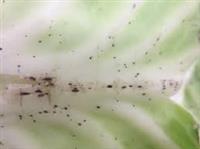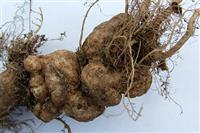BSP - Black Speck (Pepper Spot)
Type: Physiological Disorder

Black Speck, also known as Pepper Spot, is a physiological disorder that affects cabbage, especially Chinese Napa Cabbage in the United States and Europe. The disease affects the outer leaves of the cabbage, but often can seen deep in the center of the head. Individual brown and black spots develops on the wrapper leaves, and then spread to the inner leaves. Dark lesions spots appear on the cabbage ribs. It appears as if black pepper was sprinkled on the midrib section of the leaves, hence the name "pepper spot". The cause is unknown, but high rates of fertilizers and fluctuations of temperatures have been reported to increase the susceptibility. Symptoms occur in the fields during growth and during cold storage. The best option is to use disease resistant varieties.
CR – Clubroot
Scientific Name: Plasmodiophora brassicae
Type: Fungus

Clubroot is a world-wide fungal soil-borne disease that affects the growth of cabbage, cauliflower, broccoli, Brussels sprouts, kohlrabi, radishes, rutabaga, tomatoes, and turnips. This disease can cause severe crop yields and total crop loss. The fungus infects the plant through root hairs or wounds. Symptoms include wilting and yellowing of leaves. Young plants are stunted and may die. The roots are usually swollen and distorted (clubbed). The disease is spread by farm equipment, wind, and water. The infected plants should be removed and burned to avoid further infestation. The disease is favorable when temperatures are 54-81 F and usually occur when soil is moist. The disease is primarily associated with acid soils. Plan on using a 7 year crop rotation and avoid planting in the same location, year after year, as the disease can survive in the soil up to 20 years. Use proper weed control techniques. Proper tillage practices may be helpful in managing the disease. It is essential that hydrated lime be added each year to the soil unless the soil pH exceeds 7.5. Thoroughly clean equipment after working in a field. Plant crops in well drained soil. The best option is to use disease resistant varieties.